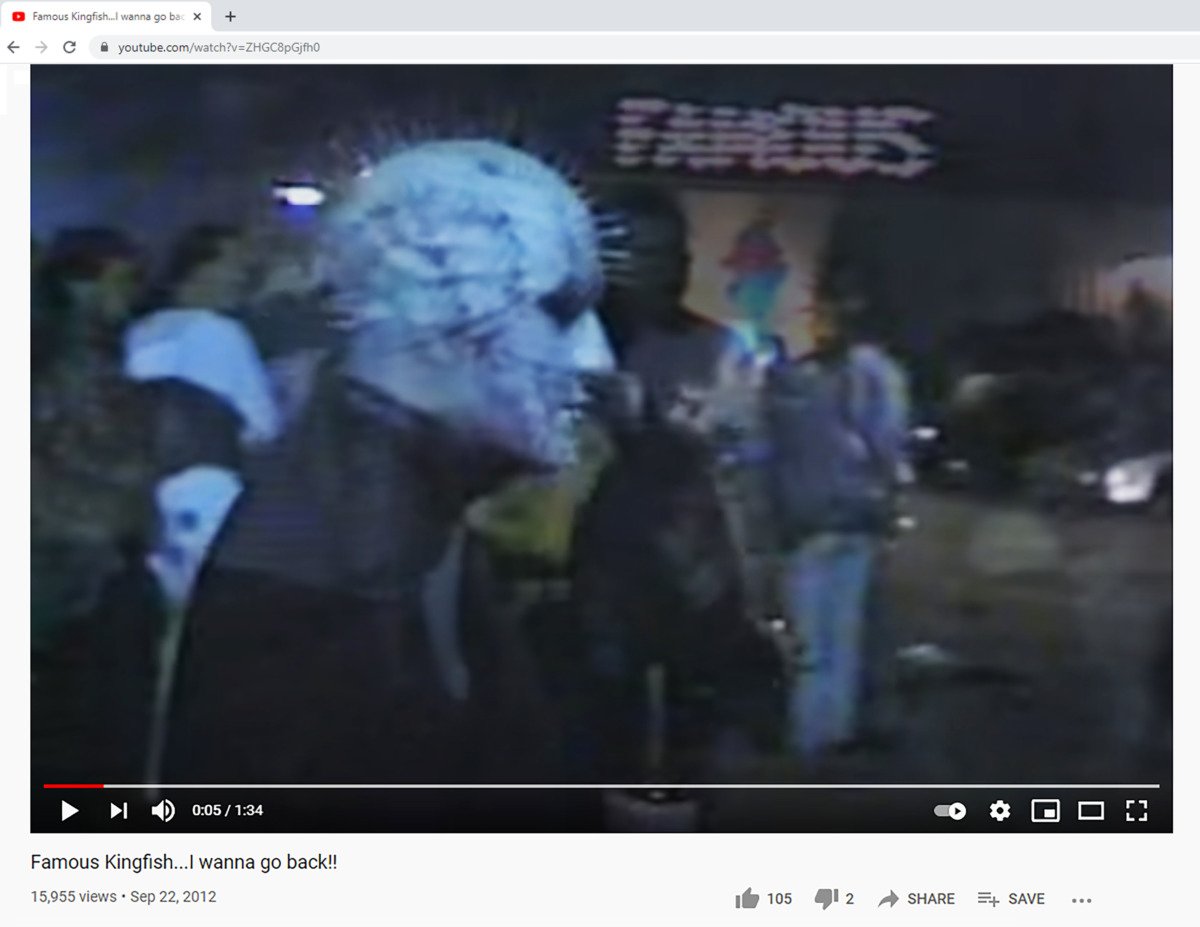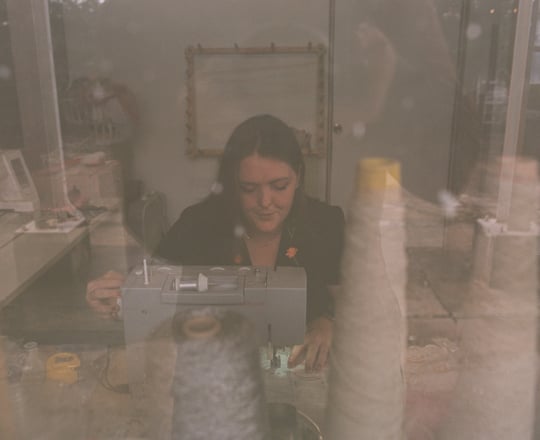On September 22, 2012, YouTube user TheBasinbum uploaded a video titled “Famous Kingfish…I wanna go back!!”[1] It presents a parking lot full of dancing young adults, lit by the blue glow of overhead parking lamps. A comment identifies “Fantasy” by Debbie Deb playing in the background. A brief debate about the identity of a blonde woman dancing slightly removed from the crowd follows. A comment suggests it might be “Kim M.” Three years later, a follow-up: “No Kim M thats Mandy M.”[2]
Another user acknowledges that “this video is so rare because everyone was so paranoid of cameras” and others echo a level of reverence: “Great rare footage!” and “unless you been [sic] there you would never know…”[3] The scene is ephemeral but the video gives it evidentiary authority; the building in the distance is barely noticeable, but its brief appearance is self-identifying. At 0:05, a bald, genderless figure in a black coat with white skin and what appear to be needles protruding from its scalp—like Pinhead from Hellraiser—passes in front of the camera (Figure 1). The figure briefly covers and then reveals the word “FAMOUS” spelled out in halogen bulbs on the side of a prefabricated metal shed not far beyond the crowd. The camera pans back to the blonde woman, who holds the focus of the crowd, and the needled silhouette slips into the mob.

The shed, Kim (or Mandy), and the needled figure tell a brief story of a uniquely regional architecture that cannot be traced through historic records or property deeds. The late 1980s saw an upswing in the number of short-lived, ad hoc dance clubs across the United States, paralleling the popularity of MDMA (ecstasy/molly). Most large cities in the South had at least one of these clubs, which have since been memorialized through fringe documentaries and memorabilia. However, they were equally popular on the exurbs, but kept as much closer secrets there due to increasing conservatism outside of city centers. The Famous Kingfish is an example of one, serving a very specific exurban clientele.

In the late seventeenth century, Acadian exiles from Nova Scotia settled in swampy, fertile prairies three hours west of New Orleans. The Cajun people, as they became known through anglicization, remained a uniquely dense and preserved ethnic group for centuries, insulated by poverty, lack of education, and cultural otherness. In its brief life during the 1980s, the Kingfish served as a critical exurban sanctuary space for a subsect of young Cajuns within a community largely defined by its deep Roman Catholic conservatism. The necessity of its secrecy, however, makes the Kingfish part of a unique architectural history that evades most historical databases, one that exists only through word of mouth and sparse internet trails. The work of uncovering the Kingfish, a place so uniquely of its own time, belongs to a very different moment: access to the internet and imaging software has led to crowdsourcing, image sharing, and satellite geolocation of forgotten architectural spaces online. Stories of once-hidden architecture proliferate alongside the mass dissemination of images, creating archives outside of traditional databases. The work of uncovering these buildings can be challenging, but as digital resources continue to multiply, other architectural ghosts like the Kingfish are likely waiting to be risen from their graves.

A Google search for “The Famous Kingfish” provides three relevant links. The first is an Amazon listing by the company Louisiana Tshirts [sic] for a gray shirt with a vector graphic of a crown above the word “FISH” and the caption “YEAH, BUT DID YOU DIE?”.[4] The second link is a local news article from 2018, posted by the Daily Advertiser of Lafayette, Louisiana, titled “A party until sunrise, Kingfish was the place to be.”[5] It features a video of an undecorated, prefab metal shed, with a brief shot of a dark, nondescript interior filled with scrap wood. Text on the video reads, “Kingfish, a famous night club in the 1980s, sits abandoned in 2018. Fans from as far as New Orleans and Houston once filled the club.”[6] The article provides a brief history of the building: its founder, DJ Brooks Taylor, was inspired by the larger, more well-known Starck Club in Dallas, to started his own dance club in an empty field on the edge of the Vermillion River, just south of Bayou Teche. He admits that the club was short-lived, but widely popular after gaining a reputation as an “ecstasy club,” which opened at 2AM on Saturdays and closed when customers left “in the Sunday morning sun.”[7] Another DJ, Carl Rachon, recalls a drug bust at the end of Kingfish’s life, which sent people “jumping the fence on the backside and running into the swamp to get away.”[8] In a seemingly continued effort to maintain its secrecy, the article’s author does not identify its location. The video provides no obvious identifiers of what could be one of the many empty swamps south of Lafayette, other than perhaps a few oddly out-of-place palm trees.
The third link, to lousianadancehalls.com, leads to little more than a one-sentence description and two broken image links. However, it provides a critical piece of evidence: an address, listed as 1099 Lake Martin Road.[9]
Searching the address on Google Maps leads to a uniquely twenty-first-century hunt, perhaps more effectively performed by the internet-savvy children of Kingfish patrons than the patrons themselves. An initial sticking point, “1099 Lake Martin Road,” directs to a small house on a short road leading to the Swamp Tours of Acadiana on Lake Martin. Satellite and street views provide no evidence of a metal shed matching the one seen in the YouTube video. Panning to the other side of the lake leads to Prairie Hwy 353. Zooming in and scrolling west, as the highway crosses the Vermillion River, Google Maps reveals a second name: Lake Martin Road, confusingly unrelated to the street where the pin initially dropped. Near this intersection, a pin lists “Mudbugz Mudpark” as an “amusement park ride.”[10] A Google search leads to the Facebook page of a group which meets “1 day per month” in the adjacent swamp, permitting “4×4’s only… NO race quads or dirt bikes allowed.”[11] The page’s 1,463 photos of 4x4s in the swamp do not include any building.

The street view of this intersection reveals a familiar scene (Figure 2). Zooming in past what appears to have once been a large parking lot, one finds the shed from the videos, next to three unmistakably out-of-place palm trees. Mudbugz Mudpark has a small sign at the road, and a closer inspection of Satellite View (Figure 3) suggests that the group congregates in the swamp beyond the former Kingfish shed, using its driveway only for access to the road, and perhaps leaving the shed vacant as it appears in the Daily Advertiser video. Google Maps does not show the address as 1099 Lake Martin Road, but the Famous Kingfish is unmistakable to the trained eye (though perhaps not to the casual observer, as it has been stripped of its halogen bulbs). The mystery of the shed’s interior is masked by its nondescript exterior: prefabricated metal sheds are the vernacular architecture of South Louisiana. It is likely that the Mudbugz are unaware that they occupy once-sacred grounds.
The appropriation of existing or prefabricated structures in service of sub-cultural assembly is not a new phenomenon. The Famous Kingfish is likely one of many late 1980s examples of a shed hiding a dance club.. Of interest, however, is the way these buildings existed then and exist now through collective memory and storytelling—knowledge once limited to word-of-mouth transfer, and now opened to proliferate through the mass dissemination of information online. The story of the Kingfish is set in a unique moment when home video technology had become widely available, but the means of disseminating these videos to the world had not yet been invented. TheBasinbum’s video acts as a time capsule, solidified through moving images, documenting an architecture that was never intended to be documented. Like other architectures of historic refuge, the Kingfish is memorialized by its imagery, but in a way that is less reverent than it is quotidian. TheBasinbum’s Kingfish does not exist on a pedestal in a museum, but instead is displayed on the world’s largest online video database. It is free to be watched but not demanding of attention, making it both widely accessible and incredibly covert, much like the original shed that was its home. The architecture of the Kingfish’s ghost-mirrors the architecture of its life: it exists to be found, but only when looked for.
The process of hunting for the Kingfish online parallels the process of finding it during its life: one locates it through digital trails (storytelling) with automated global databases providing hints on old message boards (whispers). Although these clues are sparse and unspecific, the robustness of the digital archive amassed by networks—both crowdsourced and automated—like Google and Facebook allows the stories of these architectures to be told with unprecedented accuracy, and to a potentially much wider audience. During its life, a murmur about the Kingfish may have made its way to New Orleans, but the proximity of its architecture was never as widely accessible as it is today on Google Maps. Its reach is now greater, but perhaps its audience is smaller; the story of its architecture remains precious to only a select few, tethered to it by the ache of nostalgia and belonging. In this way, the ghost of The Famous Kingfish is less a historic monument than it is a folktale inadvertently immortalized by massive systems of image capture and proliferation. It is likely that other architectural ghosts remain buried in Google Maps, waiting to be resurrected by the hint of a whisper, though the audience for these ghosts is yet unknown.
[1] TheBasinbum, “Famous Kingfish…I wanna go back!!” YouTube Video, 1:34, September 21, 2012, https://youtu.be/ZHGC8pGjfh0/.
[2] Ibid.
[3] Ibid.
[4] Amazon, Louisana T-Shirts, “The Famous Kingfish Nightclub Lake Martin Road Lafayette LA,” accessed January 26, 2021, https://www.amazon.com/Famous-Kingfish-Nightclub-Martin-Lafayette/dp/B07PDKCYKG
[5] Herman Fuselier, “The Famous Kingfish sits abandoned in 2018.” Daily Advertiser, April 12, 2018, https://www.theadvertiser.com/videos/news/2018/04/12/-famous-kingfish-sits-abandoned-2018/33753503/
[6] Ibid.
[7] Ibid.
[8] Ibid.
[9] Louisiana Dancehalls, “Kingfish,” accessed January 26, 2021, https://louisianadancehalls.com/dance_hall/kingfish/
[10] Google Maps, “Mudbugz Mudpark,” accessed January 26, 2021, https://www.google.com/maps/place/Mudbugz+Mudpark/@30.2194009,-91.9562248,15z/data=!4m2!3m1!1s0x0:0x2b7acedf98cfcda7?sa=X&ved=2ahUKEwjYw9fc4LnuAhUGG80KHZ9nBtgQ_BIwFHoECB8QBQ/
[11] Mudbugz Mudpark, “Back at it.. bustin ruts and feeling blessed to be burning some fkn Fossil fuels with my firearm on my side!” Facebook, November 4, 2020, https://www.facebook.com/Mudbugz-Mudpark-515748731796589/

This essay is part of Burnaway’s yearlong series on Nodes and Networks.
Find out more about the three themes guiding the magazine’s publishing activities for the remainder of 2021 here.




